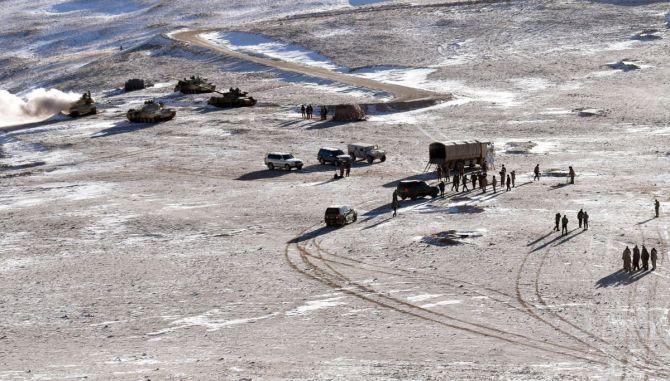'The Chinese are retaining geostrategic pressure on India by keeping troops there and building infrastructure continually.'

"The Chinese don't have to negotiate the border for quite some time, at least in Ladakh which is the most problematic of the three borders," explains Lieutenant General Rakesh Sharma, PVSM, UYSM, AVSM, VSM (retired) and former commander of the Fire and Fury Corps responsible for Kargil, Siachen Glacier and Eastern Ladakh.
"The Chinese don't do anything, tactically; everything is strategic in nature for them. There was a strategic game plan in which they wanted to create some sort of fixation of the border," the general tells Rediff.com's Archana Masih in a two-part phone interview.
After 16 rounds of military talks, Indian and Chinese troops agreed upon disengaging troops from Patrolling Point 15 in Eastern Ladakh after two-and-a-half years. What is the significance of this disengagement and what does it actually mean on the ground?
If you see the chain of places where the negotiations have been carried out over the last two-and-a-half years, Patrolling Point 15 is one more centerpiece in the whole chain which runs through the Y junction on Raki Nalla, Galwan river (PP14), Patrolling Point 15, PP 17 Alpha, Pangong Tso north and Pangong Tso south bank.
This is a chain of locations which provide access towards Aksai Chin and the Depsang Bulge.
These are areas where buffer zones have developed between the Indian Army and the People's Liberation Army.
Patrolling Point 15 is a pass on the ridge line. The pass is called Jianan La.
By climbing the pass up PP 15, our troops can reach the depth areas of the Galwan river, and also get access towards the Depsang Bulge.
Therefore, the PLA wanted to deny or stop the movement of our troops in this area. That is why in my opinion, it took such a long time to finally arrive at a consensus for the creation of the buffer zone at PP15.
The troops will now disengage at PP15.
The buffer zone means that Indian troops will not patrol to the end [of PP15] and the Chinese will not come towards PP15.
There is still no clarity about the exact area of the buffer zone as yet.
As we have seen, it took a long and difficult negotiation because the 16th round of talks took place on July 17. It took 50 days to decide on the buffer zone.
Indian troops posed a threat to the PLA if they had crossed PP15. Hence, it would have been painful for the PLA to allow Indian troops to patrol up to PP15.

As you have pointed above that buffer zones have been created in friction points where the two armies were almost eyeball to eyeball since 2020 in Eastern Ladakh.
In this particular case, PP 15 is now a no patrolling zone since it is in the buffer zone. What has been achieved by this disengagement if our troops still cannot petrol up to PP15?
The same thing is true at other friction points. We were patrolling up to Finger 8 [mountainous spurs in Pangong Tso] earlier, we are not any longer. The Chinese are also patrolling up to Finger 4, they too can't patrol up to this area. [The Chinese troops withdrew from Finger 4 in February 2021.]
At each one of these buffer zones, both forces have distanced and disentangled themselves. So instead of a Line of Actual Control, a sort of 'belt of actual control' has come into being, but this does not provide a settlement to the border dispute.
This PP15 buffer zone has pushed Indian troops a little away while the PLA has pulled back similarly, thus creating a safe zone. It may suit the Chinese who do not want fisticuffs, brawls and scuffles that used to take place regularly for years.
Our troops used to patrol up to this area and have a look around. The PLA used to also patrol the area.
In the long term analysis, it may give PLA some satisfaction of having achieved a buffer zone protecting their own troops from the fisticuffs and scuffles. But they have also pushed us away from the patrolling areas.
It's a no win situation for either side.

You had written in a paper that with these buffer zone the LAC has been fixated in Aksai Chin. Does this mean that this is the new sort of border in that area from what was the perceived LAC earlier?
This is exactly what I said. So, in some manner, it stands firmed. Hereafter, how would we proceed further is a difficult question. The Chinese may not want to discuss the border. It may suit them.
Instead of negotiating the border and settling the Line of Actual Control, we have pushed it further away by fixating the LAC into this form. Eastern Ladakh and Aksai Chin will now be separated by a benign fixated line.
What does this moratorium on patrolling at these patrolling points actually mean? How does it restrict the movement of Indian troops in areas they used to patrol earlier?
We were not putting troops in those areas. We didn't have posts there. We have a post in PP3 -- Dhan Singh Post -- but we didn't have a post in Finger 4 or Finger 8.
We did not have permanent posts in areas of Raki Nala, PP10, 11, 12 or 13, but went for patrols to those areas and the Chinese used to also patrol up to the area of Burtse which they claim as in the 1959 claim line.
So by creating this so-called 'belt of control' or buffer zones, neither are we able to patrol the areas we were patrolling earlier nor the Chinese are able to patrol the areas they were patrolling. [There are around 60 patrolling points in Eastern Ladakh.]
It is a denial on both sides. A no win situation and that is where the situation rests now.
What bearing will this forward movement in the India-China standoff have on the SCO (Shanghai Cooperation Organisation) summit, which Prime Minister Modi and Chinese President Xi Jinping will attend in Samarkhand this week?
Is it a coincidence that the breakthrough has come just before the summit?
I don't see this as a coincidence. The SCO meeting is a separate issue altogether and planned long time back. Whether the two leaders meet or don't is also not very clear as yet.
The negotiations for disengagement have been going on for the last one-and-a-half years. The discussions and finalisation would have taken some time.
If it was meant to coincide with the SCO meeting, then Demchock should have also been resolved. Demchok may take a longer time to get sorted out.
I think we tend to link these border issues with political statements, which in my opinion is not so relevant.

What do you see the Chinese intent further from this? What do you see happening in the months and years ahead?
The Chinese don't do anything, tactically; everything is strategic in nature for them.
There was a strategic game plan in which they wanted to create some sort of fixation of the border.
Chinese intentions are largely on the global stage. They harbour the Chinese dream of rejuvenating their past glory.
No nation can have global ambitions if it encounters problems on the border on a regular basis with individual countries like India, Taiwan, Japan, Vietnam and other nations of the South China Sea.
The Chinese have a timeline for everything -- to achieve some kind of a resolution in some places and they have found a method of resolving it without actually resolving it.
So now they don't have to negotiate the border for quite some time, at least in Ladakh which is the most problematic of the three borders or three regions and proceed further towards other ends.
Having said that, you have to take the contrarian view also -- the Chinese are building infrastructure rapidly in Tibet and Xinjiang -- the G695 [China plans to build highway across Aksai China], the bridge across Pangong Tso lake, the airfields have been extended, blast pens have been constructed and more airfields and heliports being constructed.
The Chinese have also constructed a large amount of habitat. The PLA formations and units which have come from Xinjiang two-and-a-half years ago will obviously not go back.
Hence, it implies that the geostrategic pressure on India will continue because the Chinese have infrastructure and forces located in this area plus the border is now safe for them.
So while the Chinese have got some kind of protection between the border and the villages, they are also retaining the geostrategic pressure on India by keeping the troops there and building infrastructure continually.
Feature Presentation: Aslam Hunani/Rediff.com










